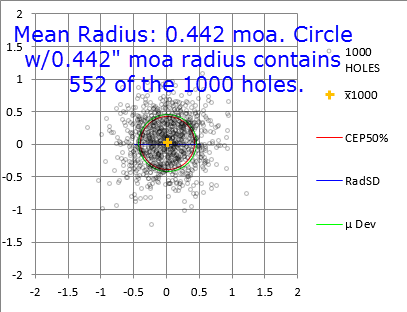My original:
There's a limit as to how small a group can be. There's no limit to how big they can be.
There's no easy way to prove what makes the tiniest groups the size they are. It's one of two things. One's when everything is perfect; all variables are at zero. The other's when all those variables are at different amounts but cancel each other out. Tiniest groups happen more often when the largest ones are the smallest. Largest groups happen when some of those variables add up in different directions maximizing the distance bullets strike from group center.
That said, if one thinks best accuracy is the smallest groups fired, shoot a few hundred of them with any rifle and one will be very, very tiny. Doesn't matter if the largest one's 10 inches and they average around 5 inches. Lake City's 7.62 NATO National lots of match ammo's shot sub 1 inch 5-shot groups at 600 yards testing it. The extreme spread of all 54 of them in a 270-shot composite is about 10 inches.
If the fact that the larger groups got smaller isn't a good indicator of real accuracy, I don't know what is. If you're gonna quote me, put everything in it so it won't be taken out of context.Not too long ago, they (stoolshooters) learned that full length sizing their fired cases made two things happen; case necks were better centered on case shoulders and their largest groups got smaller. Smallest ones stayed about the same size.
There's a limit as to how small a group can be. There's no limit to how big they can be.
There's no easy way to prove what makes the tiniest groups the size they are. It's one of two things. One's when everything is perfect; all variables are at zero. The other's when all those variables are at different amounts but cancel each other out. Tiniest groups happen more often when the largest ones are the smallest. Largest groups happen when some of those variables add up in different directions maximizing the distance bullets strike from group center.
That said, if one thinks best accuracy is the smallest groups fired, shoot a few hundred of them with any rifle and one will be very, very tiny. Doesn't matter if the largest one's 10 inches and they average around 5 inches. Lake City's 7.62 NATO National lots of match ammo's shot sub 1 inch 5-shot groups at 600 yards testing it. The extreme spread of all 54 of them in a 270-shot composite is about 10 inches.

